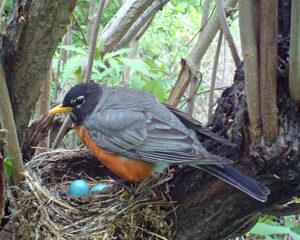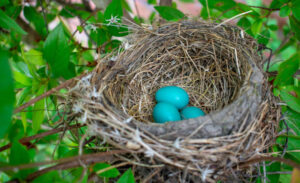Popular backyard birds, American robins can be seen hopping around on lawns across the country in search of earthworms or freshly turned dirt. The coming of spring is heralded by the nesting of American robins, who produce the season’s first visible signs of life by depositing bright blue eggs. In this article, we investigate the nesting and procreation practices of these curious backyard dwellers.
Where do American robins nest?
When it comes to choosing a nesting spot, American robins’ preferences can change depending on where they are. Robins will nest in both evergreen and deciduous trees, making both woodland and farming as well as urban surroundings good options. Tree forks can serve as a foundation for structures, as well as a support structure for lower and higher branches.
Robins will use nesting boxes and birdhouses if they are available, but they will also use man-made structures such as ledges, window sills, planters, gutters, and the underside of the eaves of a shed or barn roof.
What do American robin nests look like?
Robins build their natural nests from twigs, grass, and dried leaves, which are then bound together with mud and encased in a mud wall. When complete, the female robin’s wings will have pushed the cup-shaped interior into shape, and fine plant fibres and dead grass will have been added for padding. You could fit a baseball into the internal cup, roughly.
What time of year do American robins nest?
Robins are one of the first songbirds to start a nest in the spring. Usually, the initial nest is constructed before the leaves of deciduous trees have fully opened. Depending on your latitude in the northern hemisphere, this may occur in April or May. Donald Stokes notes that “Breeding times vary ten to fifteen days for each change of five degrees latitude” in his excellent book, Stokes Guide To Bird Behavior.
To put it another way, if you reside in Philadelphia, Indianapolis, or Denver (all of which are at a latitude of 40 degrees), you may expect to see robins building their nests around the first week of April. Some robins in Canada won’t start nesting until May, but in the south of the United States, robins begin doing so as early as March.
Although these times can serve as a rough guide, the only reliable way to determine when robins are actually nesting is to observe their behaviour in the weeks leading up to their nesting. This is also a lot more exciting because you get to see the indicators for yourself.
How long do American robins stay in their nests?
As soon as the nest is finished, the laying of eggs begins, with the average clutch size being between two and four. The female robin is the only member of the species responsible for incubating the eggs for up to 14 days. Robin chicks are first brooded by the females, but the males play an important part in feeding them once they hatch. An average year will see the raising of two to three broods. Although uncommon, a fourth brood is possible.
Nesting strategy of the American robin?
The female robin is responsible for finding a suitable nesting location and building the nest from scratch from grass, twigs, and a mud exterior. The male robin may come by the nest site before and during construction with supplies to help his female partner. Robin females build large, cup-shaped nests with rounded interior that is smoothed and moulded using moist mud from worm castings. The interiors are finished with a layer of fine grass. A female bird will spend about 5–7 days building her nest, though she may need less time on subsequent nests in the same year.
When do newborn American robins first go out of the nest?
Robin chicks are cared for by their parents for another three weeks after they leave the nest, at which point they have been there for about 13 days. The mother may have already started brooding her next clutch, leaving the male to care for the newly hatched young on his own.
How many broods do American robins have?
Most pairs of American robins will raise two or three broods per year, although occasionally a fourth brood will be attempted and successful. Every time a new batch of eggs is due to hatch, a brand-new nest is constructed.
Do American robins nest in the same place every year?
Even within the same year, robins may often build a brand-new nest for each clutch. They may, however, return to an old nesting location for supplies or to serve as a starting point for a new one.
What do American robin eggs look like?
The name “robin egg blue” comes from the vivid blue of the eggs laid by American robins. There are no spots or other marks on an egg. Comparable to the size and weight of a quarter.
Do American robins use nest boxes?
For American robins to use a nest box, it must be built to specific specifications and put in a specific location. Instead of seeking cover among plants, robins would instead nest in an open-fronted box with a clear view of the outdoors, much like a nesting shelf. Placement of such boxes on the side of a building or beneath the eaves of a roof is more likely to attract robins as tenants. The nest box must be large enough for the robin to create its own base of twigs and mud on which to deposit its eggs, so size is an issue for a brooding robin.
Where do American robins nest at night?
While female robins are tending to their young, the males will congregate at roosting sites such as tree branches, barns, or even under bridges. The juvenile robins will sleep with the males in the roosts after they have learned to fly. Adult female robins only visit roosts once they have done nesting. Thousands, if not tens of thousands, of robins, may share a single roosting location.
Do American robins nest in backyards?
There is no reason why a robin won’t nest in a backyard if the other conditions are right. A large thicket or shrubbery, or even just a shady tree on the lawn, could provide the necessary cover for a nest. Attaching a robin house, which often has an open front, to a house or shed can entice the birds to set up nests in close proximity to people.





